Taibai Fish-Head Soup: A Poet’s Culinary Legacy
1. Origin: A Poet by the River, A Dish with His Name
In China’s vast culinary world, every famous dish has a story. In Anhui Province, beyond the poetic beauty of Huangshan and Huizhou architecture, one local delicacy stands out — Taibai Fish-Head Soup.
This dish traces its origin back to Li Bai, the legendary Tang dynasty poet known for his free spirit and love of wine.
According to local legend, Li Bai spent his later years in Dangtu County, Ma’anshan, where he often wrote poems along the Yangtze River near Caishi Cliff. One evening, fishermen brought him a large silver carp (also known as bighead carp). Inspired by its plump head, Li Bai instructed his boatmen to stew it with tofu and simple seasonings. The soup turned a milky white, fragrant, and full of flavor. Impressed, the poet composed a verse in praise, and locals named it “Taibai Fish-Head Soup” to honor him. Since then, it has become a symbol of Anhui’s culture, merging poetry and cuisine.
2. Cultural Heritage: More Than a Dish, a Living Tradition
Taibai Fish-Head Soup has become part of Ma’anshan’s cultural identity. It reflects the riverside people’s creativity, transforming the Yangtze’s bounty into refined, nourishing food.
The dish also represents Hui Cuisine’s spirit: blending food with poetry, painting, and philosophy.
At important family banquets, festivals, and when entertaining honored guests, a steaming pot of Taibai Fish-Head Soup is often served as the finale, symbolizing respect and hospitality. Each sip brings you closer to Li Bai’s poetic vision — simple, natural, and full of life.

3. The Soul of the Soup: Selecting the Right Ingredients
A perfect Taibai Fish-Head Soup begins with freshness and balance.
- Main ingredient: Choose a fresh bighead carp or silver carp head from the Yangtze River or a clean local reservoir. The best fish heads are large, fatty, and collagen-rich, which ensures a creamy broth.
- Supporting ingredients: Silky tofu absorbs the rich broth, bamboo shoots add crisp sweetness, and slices of Jinhua ham or Xuanwei ham bring depth and umami.
- Aromatics: Ginger, scallion, and a splash of Chinese cooking wine remove fishiness and enhance the fragrance.
4. Technique: From Golden Sear to Milky Perfection
The signature white, creamy broth comes not from dairy, but from skill.
- Sear to seal flavor: Pat the fish head dry, then sear both sides in hot oil with a pinch of salt until golden brown. This step locks in moisture and removes any fishy taste.
- Add boiling water: Immediately pour in a generous amount of boiling water, never cold. The high temperature emulsifies fat, collagen, and protein, turning the broth milky within minutes.
- Simmer gently: Add tofu, ham, and bamboo shoots, then simmer for 15–20 minutes over medium heat. The flavors blend into a rich, silky soup. Season lightly with salt and white pepper before serving.

5. A Symphony of Taste: One Spoonful, Pure Comfort
The first spoonful of Taibai Fish-Head Soup is unforgettable. The milky white broth is visually soothing, and the flavor offers layers of umami, the sweetness of fish, the saltiness of ham, and the light crispness of bamboo.
Each sip feels rich yet clean, coating your lips and warming the throat. The fish meat falls off the bone, delicate and juicy, while tofu melts in the mouth, absorbing the savory broth perfectly.
6. How to Enjoy It: Traveler’s Tips
How to eat:
- Start with the clear broth to appreciate its pure freshness.
- Then taste the fish and tofu.
- For the finale, pour the soup over steamed rice or dip fried dough sticks (youtiao) or sesame cakes into the broth.
Pairing suggestions:
- Enjoy with seasonal greens or cold appetizers.
- A glass of Huangjiu (yellow wine) or Chinese green tea makes a perfect pairing.
Where to try it:
- For authentic flavor, visit Dangtu County, Ma’anshan, especially around the Caishi Cliff Scenic Area, where local restaurants specialize in river fish.
- Upscale Hui cuisine restaurants in Hefei and other cities also offer refined versions.
Best season:
- Autumn and winter, when river fish are fattier and more flavorful.

7. Cook It Yourself: A Simple Family Recipe
Ingredients:
1 fish head (bighead or silver carp), 1 block of firm tofu, 3 slices of cured ham, ginger slices, scallions, cooking wine, salt, white pepper, and oil.
Steps:
- Clean and pat the fish head dry; cut tofu into chunks.
- Heat oil and ginger, then sear the fish head until golden.
- Add boiling water to cover, bring to a strong boil.
- When the broth turns white, add ham and cooking wine; simmer 10 minutes.
- Add tofu and simmer another 10 minutes.
- Season with salt and white pepper, top with scallions, and serve hot.
Tips:
The key to a milky broth is searing properly, adding boiling water, and keeping a strong boil.
8. Conclusion
Taibai Fish-Head Soup is more than a dish; it’s a story that has simmered for over a thousand years. Born from Li Bai’s poetic spirit and the Yangtze River’s bounty, it embodies Anhui’s cultural soul.
A bowl of this creamy, fragrant soup is a taste of history — simple, elegant, and deeply satisfying.
When you travel to Anhui, make sure to savor this timeless delicacy, a perfect harmony of poetry, nature, and flavor.


